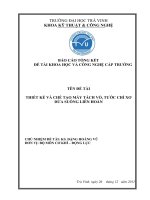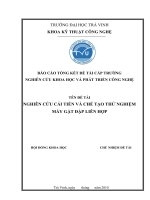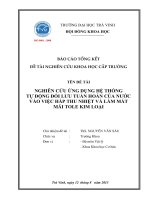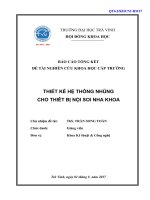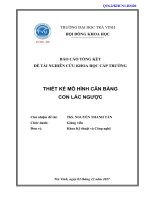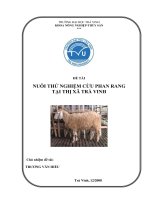Báo cáo nghiên cứu khoa học cấp trường: Kỹ thuật thủy vân trong xác nhận bản quyền số
Bạn đang xem bản rút gọn của tài liệu. Xem và tải ngay bản đầy đủ của tài liệu tại đây (4.86 MB, 27 trang )
QT6.2/KHCN1-BM22
TRƯỜNG ĐẠI HỌC TRÀ VINH
HỘI ĐỒNG KHOA HỌC
ISO 9001 : 2008
BÁO CÁO TỔNG KẾT
ĐỀ TÀI NGHIÊN CỨU KHOA HỌC CẤP TRƯỜNG
KỸ THUẬT THỦY VÂN TRONG XÁC NHẬN
BẢN QUYỀN SỐ
Chủ nhiệm đề tài:
Chức danh:
Đơn vị:
TS. NGUYỄN THÁI SƠN
Giảng viên
Khoa Kỹ thuật và Công nghệ
Trà Vinh, ngày 02 tháng 08 năm 2017
1
TRƯỜNG ĐẠI HỌC TRÀ VINH
HỘI ĐỒNG KHOA HỌC
ISO 9001 : 2008
BÁO CÁO TỔNG KẾT
ĐỀ TÀI NGHIÊN CỨU KHOA HỌC CẤP TRƯỜNG
KỸ THUẬT THỦY VÂN TRONG XÁC NHẬN
BẢN QUYỀN SỐ
Xác nhận của cơ quan chủ quản
Chủ nhiệm đề tài
(Ký, đóng dấu, ghi rõ họ tên)
(Ký, ghi rõ họ tên)
Nguyễn Thái Sơn
Trà Vinh, ngày 02 tháng 08 năm 2017
2
TÓM TẮT
Xác nhận bản quyền số thuận nghịch thu hút được nhiều sự quan tâm của các nhà
khoa học do kỹ thuật này có khả năng khôi phục lại dữ liệu gốc của những ảnh
mang tin mà không có bất kỳ thay đổi nào sau khi được xác nhận. Trong đề tài này,
chúng tôi đưa ra một giải pháp xác nhận bản quyền số thuận nghịch mới dựa vào
tiên đoán hình thoi và đánh giá độ phức tạp. Để đảm bảo chất lượng ảnh đã mang
tin cao và đạt được độ chính xác cao trong kiểm tra giả mạo, đánh giá độ phức tạp
được thực hiện trên mỗi điểm ảnh. Sau đó, những lỗi tiên đoán được tín toán dựa
vào tiên đoán hình thôi cho việc giấu mã xác nhận. Kết quả thực nghiệm thể hiện
rằng giải pháp đề xuất có khả năng khôi phục lại phiên bản gốc của ảnh chủ. Ngoài
ra, giải pháp đề xuất còn đạt được các hiệu quả tốt hơn so với các giải pháp trứơc
xết về mặt kiểm tra giả mạo và chất lượng ảnh.
Reversible image authentication attracts much attention of researchers since such
technique has ability to reconstruct the original version of the host image losslessly
after image authentication. In this paper, we propose a new reversible image
authentication based on rhombus prediction and local complexity. To maintain
good quality of stego images and to achieve high accuracy of tamper detection, the
local complexity of each pixel is first evaluated, then, the prediction error is
calculated by using rhombus prediction for embedding the authentication code.
Experimental results demonstrated that the proposed scheme has ability to recover
the original version of the host images. In addition, the proposed scheme obtains
better performance than previous schemes in terms of tamper detection and image
quality.
3
MỤC LỤC
LỜI CẢM ƠN ......................................................................................................... 7
PHẦN MỞ ĐẦU ..................................................................................................... 8
1.
Tính cấp thiết của đề tài ............................................................................... 8
2.
Tổng quan nghiên cứu.................................................................................. 8
3.
Mục tiêu....................................................................................................... 9
4.
Đối tượng, phạm vi và phương pháp nghiên cứu ........................................ 10
PHẦN NỘI DUNG ............................................................................................... 11
CHƯƠNG 1. Giải pháp đề xuất........................................................................ 11
CHƯƠNG 2. So sánh và đánh giá kết quả thực nghiệm của giải pháp mới được
đề xuất
17
PHẦN KẾT LUẬN ............................................................................................... 25
TÀI LIỆU THAM KHẢO ..................................................................................... 26
4
DANH MỤC BẢNG BIỂU
Table 1. Embedding capacity (bits) under different thresholds ........................................ 17
Table 2. Visual quality (dB) under different thresholds ................................................... 17
Table 3. Performance comparison of the proposed scheme and Lo and Hu’s scheme for the
tamper object A1 ............................................................................................................. 20
Table 4. Performance comparison of the proposed scheme and Lo and Hu’s scheme for the
tamper object B1 ............................................................................................................. 20
Table 5. Performance comparison of the proposed scheme and Lo and Hu’s scheme for the
tamper object C1 ............................................................................................................ 21
Table 6. Performance comparison of the proposed scheme and Lo and Hu’s scheme for the
tamper object D1 ............................................................................................................. 22
Table 7. Performance comparison of the proposed scheme with previous image
authentication schemes .................................................................................................... 23
5
DANH MỤC CÁC BIỂU ĐỒ, SƠ ĐỒ, HÌNH ẢNH
Figure 1. Flowchart of the embedding procedure .................................................. 11
Figure 2. Illustration of the host image with black and white sets ......................... 12
Figure 3. Flowchart of the extracting procedure .................................................... 14
Figure 4. The current processing block B with white color implying the legal block
and with black color implying the tampered block .................................................16
Figure 5. Six test images with the size of 512 512 .............................................16
Figure 6. A1, B1, C1, and D1 are four tampered color objects. A2, B2, C2, and D2
are four corresponding grayscale objects. A3, B3, C3, and D3 are four
corresponding tampered images.............................................................................19
6
LỜI CẢM ƠN
Tôi xin gửi lời cảm ơn chân thành và sự tri ân sâu sắc đối với trường Đại học
Trà Vinh, đặc biệt là Khoa Kỹ thuật & Công nghệ của trường đã giành nhiều
thời gian cho tôi thực hiện đề tài nghiên cứu khoa học tại Khoa. Đồng thời,
nhà trường đã tạo cho tôi có cơ hội được tìm hiểu và áp dụng những kiến
thức sâu rộng của khoa học máy tính vào một đề tài cụ thể. Qua thời gian
thực hiện đề tài này tôi nhận ra nhiều kiến thức mới mẻ và bổ ích trong việc
nghiên cứu và giảng dạy để giúp ích cho công việc hiện tại và sau này của
tôi.
Tôi xin chân thành cảm ơn!
7
PHẦN MỞ ĐẦU
1. Tính cấp thiết của đề tài
Với sự phát triển mạnh của đa phương tiện và mạng máy tính, dữ liệu số đã
được dùng một cách rộng rãi để thay thế những dữ liệu được lưu trữ theo cách
truyền thống. Khi dữ liệu số được truyền trên một kênh phổ thông như mạng
Internet, những dữ liệu số này phải đối mặt với những sửa đổi, sao chép một
cách không hợp pháp hay giả mạo từ những kẻ tấn công. Chính vì vậy, vấn đề
bảo vệ sự an toàn và bảo mật của thông tin được lưu trữ hay được truyền đi
trở thành một vấn đề rất quan trọng và cấp thiết. Điều này thu hút sự quan tâm
đặc biệt của các nhà nghiên cứu trong nhiều lĩnh vực khác nhau. Nhiều giải
pháp đã được đưa ra để giải quyết vấn đề này, như mã hoá thông tin
(cryptography) [34-35] và thuỷ vân số (watermarking) [1-33]. Trong đó, thuỷ
vân số được xem như một trong những giải pháp hứa hẹn nhất hiện nay. Thuỷ
vân số là một phương pháp nhúng thông tin bí mật, ví dụ như logo của doanh
nghiệp, vào dữ liệu đa phương tiện gốc, ví dụ như văn bản, hình ảnh, audio,
và video, để tránh sự quan tâm của những kẻ tấn công (attackers) vào thông
tin được nhúng. Vì vậy thuỷ vân số đảm bảo được sự an toàn của thông tin
mật được nhúng. Thuỷ vân số có thể được phân loại dựa trên miền của dữ liệu
gốc chứa tin, như miền không gian (spatial domian), miền tần số (frequency
domain), miền nén (compression domain). Trong các năm gần đây việc mất
an toàn thông tin diễn ra một cách mạnh mẽ hơn. Do đó, việc nghiên cứu và
đề xuất các giải pháp thuỷ vân số mới với tính bảo mật cao hơn phần nào giúp
giảm bớt sự tấn công của những người không được phép, điều này thu hút sự
quan tâm của rất nhiều nhà nghiên cứu trong và ngoài nước.
2. Tổng quan nghiên cứu
Trong các năm qua, nhiều giải pháp thuỷ vân số cho ảnh số đã được giới thiệu
trên thế giới. Năm 2008, Lee and Lin [1] đề xuất một kỹ thuật thuỷ vân số,
giải pháp này không những có thể kiểm tra được vùng giả mạo trên ảnh đã
được nhúng thông tin mật, mà còn có khả năng khôi phục dữ liệu gốc của khu
vực đã bị giả mạo đó. Trong giải pháp của Lee and Lin, mỗi khối ảnh có thể
được dùng để chứa dữ liệu mật và dữ liệu nén của hai khối ảnh khác. Năm
2010, Ahmed and Siyal [2] đưa ra một giải pháp thuỷ vân số để xác nhận ảnh
dựa trên hàm băm (hash function). Giải pháp của Ahmed and Siyal đạt được
tính bền vững (robustness) đối với một vài kiểu tấn công như: nén JPEG, lọc
bỏ qua phần trầm (low-pass filtering) và lọc bỏ qua phần cao (high-pass
filtering). Đến năm 2011, để chống lại những thay đổi bất hợp pháp trên ảnh
nén lượng tử vector (vector quantizaion compressed image), Chuang and Hu
[3] giới thiệu một phương pháp thuỷ vân số mới. Trong phương pháp này, hai
tập của dữ liệu xác nhận được sử dụng để xử lý kiểm tra giả mạo và xác nhận
với ảnh nén đã được cung cấp. Tuy nhiên, chất lượng của ảnh chứa tin còn
thấp. Sau đó, năm 2013, để cải thiện những yếu kém trong giải thuật của
8
Chuang and Hu, Hu và cộng sự [4] đã đề xuất giải pháp thuỷ vân số mới cho
ảnh số kết hợp với phương pháp nén BTC (block truncation code). Trong [4],
mã xác nhận của khối ảnh sẽ được tạo ra từ mức lượng tử của ảnh nén. Sau
đó, nhiều bản sao của mã xác nhận sẽ được giấu trong bản đồ bit (bit map)
bằng phương pháp hoán vị (permutaion operation). Năm 2014, chúng tôi [5]
đã đề xuất một phương pháp thuỷ vân số mới trong việc bảo vệ toàn vẹn dữ
liệu ảnh nén BTC. Để đạt được chất lượng ảnh tốt hơn, một bảng tham chiếu
(reference table) được thiết lập và được dùng trong khi giấu những mã xác
nhận. Vì vậy, chất lượng ảnh được cải thiện trong giải pháp của chúng tôi.
Tuy nhiên, bằng cách dựa vào miền không gian và miền nén để giấu thông tin
mật và áp dụng cho việc xác nhận nhưng thay đổi không hợp pháp trên ảnh
số, đa số các giải pháp đã đề xuất [1-5] đều làm giảm đáng kể chất lượng của
ảnh chứa tin mật, luôn nhỏ hơn 50 dB. Để nâng cao chất lượng của ảnh chứa
tin, trong [6], Preda đã giới thiệu một giải pháp thuỷ vân số mới dùng trong
xác nhận ả������������������������������������������������������������������������������������������������������������������������������������������������������������������������������������������������������������������������������������������������������������������������������������������������������������������������������������������������������������������������������������������������������������������������������������������������������������������������������������������������������������������������������������������������������������������������������������������������������������������������������������������������������������������������������������������������������������������������������������������������������������������������������������������������������������������������������������������������������������������������������������������������������������������������������������������������������������������������������������������������������������������������������������������������������������������������������������������������������������������������������������������������������������������������������������������������������������������������������������������������������������������������������������������������������������������������������������������������������������������������������������������������������������������������������������������������������������������������������������������������������������������������������������������������������������������������������������������������������������������������������������������������������������������������������������������������������������������������������������������������������������������������������������������������������������������������������������������������������������������������������������������������������������������������������������������������������������������������������������������������������������������������������������������������������������������������������������������������������������������������������������������������������������������������������������������������������������������������������������������������������������������������������������������������������������������������������������������������������������������������������������������������������������������������������������������������������������������������������������������������������������������������������������������������������������������������������������������������������������������������������������������������������������������������������������������������������������������������������������������������������������������������������������������������������������������������������������������������������������������������������������������������������������������������������������������������������������������������������������������������������������������������������������������������������������������������������������������������������������������������������������������������������������������������������������������������������������������������������������������������������������������������������������������������������������������������������������������������������������������������������������������������������������������������������������������������������������������������������������������������������������������������������������������������������������������������������������������������������������������������������������������������������������������������������������������������������������������������������������������������������������������������������������������������������������������������������������������������������������������������������������������������������������������������������������������������������������������������������������������������������������������������������������������������������������������������������������������������������������������������������������������������������������������������������������������������������������������������������������������������������������������������������������������������������������������������������������������������������������������������������������������������������������������������������������������������������������������������������������������������������������������������������������������������������������������������������������������������������������������������������������������������������������������������������������������������������������������������������������������������������������������������������������������������������������������������������������������������������������������������������������������������������������������������������������������������������������������������������������������������������������������������������������������������������������������������������������������������������������������������������������������������������������������������������������������������������������������������������������������������������������������������������������������������������������������������������������������������������������������������������������������������������������������������������������������������������������������������������������������������������������������������������������������������������������������������������������������������������������������������������������������������������������������������������������������������������������������������������������������������������������������������������������������������������������������������������������������������������������������������������������������������������������������������������������������������������������������������������������������������������������������������������������������������������������������������������������������������������������������������������������������������������������������������������������������������������������������������������������������������������������������������������������������������������������������������������������������������������������������������������������������������������������������������������������������������������������������������������������������������������������������������������������������������������������������������������������������������������������������������������������������������������������������������������������������������������������������������������������������������������������������������������������������������������������������������������������������������������������������������������������������������������������������������������������������������������������������������������������������������������������������������������������������������������������������������������������������������������������������������������������������������������������������������������������������������������������������������������������������������������������������������������������������������������������������������������������������������������������������������������������������������������������������������������������������������������������������������������������������������������������������������������������������������������������������������������������������������������������������������������������������������������������������������������������������������������������������������������������������������������������������������������������������������������������������������������������������������������������������������������������������������������������������������������������������������������������������������������������������������������������������������������������������������������������������������������������������������������������������������������������������������������������������������������������������������������������������������������������������������������������������������������������������������������������������������������������������������������������������������������������������������������������������������������������������������������������������������������������������������������������������������������������������������������������������������������������������������������������������������������������������������������������������������������������������������������������������������������������������������������������������������������������������������������������������������������������������������������������������������������������������������������������������������������������������������������������������������������������������������������������������������������������������������������������������������������������������������������������������������������������������������������������������������������������������������������������������������������������������������������������������������������������������������������������������������������������������������������������������������������������������������������������������������������������������������������������������������������������������������������������������������������������������������������������������������������������������������������������������������������������������������������������������������������������������������������������������������������������������������������������������������������������������������������������������������������������������������������������������������������������������������������������������������������������������������������������������������������������������������������������������������������������������������������������������������������������������������������������������������������������������������������������������������������������������������������������������������������������������������������������������������������������������������������������������������������������������������������������������������������������������������������������������������������������������������������������������������������������������������������������������������������������������������������������������������������������������������������������������������������������������������������������������������������������������������������������������������������������������������������������������������������������������������������������������������������������������������������������������������������������������������������������������������������������������������������������������������������������������������������������������������������������������������������������������������������������������������������������������������������������������������������������������������������������������������������������������������������������������������������������������������������������������������������������������������������������������������������������������������������������������������������������������������������������������������������������������������������������������������������������������������������������������������������������������������������������������������������������������������������������������������������������������������������������������������������������������������������������������������������������������������������������������������������������������������������������������������������������������������������������������������������������������������������������������������������������������������������������������������������������������������������������������������������������������������������������������������������������������������������������������������������������������������������������������������������������������������������������������������������������������������������������������������������������������������������������������������������������������������������������������������������������������������������������������������������������������������������������������������������������������������������������������������������������������������������������������������������������������������������������������������������������������������������������������������������������������������������������������������������������������������������������������������ is restored according to two
reconstructed sets, SB and SW. Otherwise, the image is divided into
blocks with the size of 4 × 4 pixels. For each block, if there are any
tampered pixels, the block is marked as a tampered block. Otherwise,
the block is marked as a legal block. Then, the detected image is
generated by gathering all of the legal and tampered blocks.
Step 6: To improve the accuracy of the detected images, we use a refinement
process. In this process, each legal block in the detected image is
examined whether or not it belongs to one of the four cases in Figure
4. If a block belongs to one of these four cases, the block is changed to
the tampered block. This process will be implemented repeatedly until
none of blocks are changed to the tampered block. Eventually, the
16
refined detected image is obtained and the extracting procedure is
terminated.
Figure 4. The current processing block B with white color implying the legal
block and with black color implying the tampered block
CHƯƠNG 2. So sánh và đánh giá kết quả thực nghiệm của giải pháp
mới được đề xuất
In this section, we conducted various experiments to evaluate the
performance of the proposed scheme. Six test images, i.e., “Airplane,”
“Boat,” “Lena”, “Peppers,” “Tiffany,” and “Toys,” shown as Figure 5, are
used in the experiment. Different values of the complexity threshold and the
embedding threshold, i.e., TH = 4, 8, or 14, and T* = 0, 1, 2, or 3, are used for
testing. Tables 1 and 2 provide embedding capacity and image quality under
such different thresholds. As can be seen in Tables 1 and 2, if the larger
values of TH and T* are used, the higher embedding capacity and the lower
image quality (PSNR) are obtained. The main reason is when the larger value
of threshold is used; more pixels are selected for embedding the
authentication code, resulting in the image is distorted significantly.
Figure 5. Six test images with the size of 512 512
17
Table 1. Embedding capacity (bits) under different thresholds
Images T* = 0 T* = 1 T* = 2 T* = 3
Airplane 47466 107251 131727 142088
Boat
26617 65909 88548 102571
Lena
38251 89532 112646 123030
TH = 4 Peppers 32444 78258 103224 117226
Tiffany 35316 84044 109933 124994
Toys
27504 67445 91021 107345
Average 34599 82073 106183 119543
Airplane 52803 125447 162230 179508
Boat
30486 80506 116011 138694
Lena
47347 118457 157968 177213
TH = 8 Peppers 41508 107144 149791 174817
Tiffany 41592 105618 146986 171649
Toys
32545 86736 126522 153313
Average 41046 103984 143251 165865
Airplane 54520 131343 172332 193815
Boat
32362 86633 126798 154196
Lena
50757 128819 175107 199670
TH =
Peppers 43661 114771 163370 193958
14
Tiffany 43059 110546 156082 185070
Toys
33670 90781 134223 165675
Average 43004 110482 154652 182064
Table 2. Visual quality (dB) under different thresholds
Images T*=0
T*=1
T*=2
T*=3
Airplane 52.79
48.27
46.39
45.51
Boat
53.55
48.29
45.73
44.39
Lena
53.45
48.72
46.70
45.74
TH = 4 Peppers 53.30
48.25
45.89
44.70
Tiffany 52.81
47.76
45.35
44.07
Toys
53.03
47.70
45.05
43.59
Average 53.15
48.16
45.85
44.66
Airplane 51.85
46.95
44.71
43.57
Boat
52.44
46.81
43.96
42.37
Lena
52.09
46.96
44.61
43.46
TH = 8 Peppers 51.82
46.38
43.74
42.36
Tiffany 51.61
46.15
43.43
41.94
Toys
51.98
46.24
43.32
41.68
Average 51.96
46.58
43.96
42.56
18
Airplane 51.42
46.33
43.88
42.54
Boat
51.75
45.97
42.96
41.20
Lena
51.51
46.24
43.71
42.38
TH =
Peppers 51.37
45.81
43.04
41.50
14
Tiffany 51.19
45.59
42.70
41.02
Toys
51.58
45.75
42.71
40.94
Average 51.47
45.94
43.16
41.59
To estimate the accuracy of tamper detection, the normalized correlation
coefficient (NCC) rate is used to measure the similarity between the detected
image and the tampered image which is defined by:
∑
NCC =
(∑
∑
∑
[ ,
[ ,
][
] )(∑
]
,
∑
[ ,
,
(8)
] )
where T is the binary form of the tampered object and Tmean is the mean value
of all pixels in T. D is the detected image and Dmean is the mean value of all
pixels in D.
For testing tamper detection, four different tampered color objects are
converted to grayscale level and used in the proposed scheme as shown in
Figure 6. Here, two first tampered color objects, A1 and B1, are very smooth
image type with the complicated shape, C1 is the normal image type, and D1
is the complex one, respectively. In the experiment, to simulate tamper
operation, the image “Lena” is embedded the authentication code. Then, each
tampered object is added subsequently on the wall of the stego image “Lena”
as shown in Figure 6.
A1
A2
A3
B1
B2
B3
19
C1
C2
C3
D1
D2
D3
Figure 6. A1, B1, C1, and D1 are four tampered color objects. A2, B2, C2,
and D2 are four corresponding grayscale objects. A3, B3, C3, and D3 are four
corresponding tampered images
To illustrate the superior performance of our scheme, we compared the
proposed scheme with Lo and Hu’s scheme [17] since their scheme achieved
the reversibility as that of the proposed scheme. In Lo and Hu’s scheme, the
parameter p = 1 or 2 is used because the similar results are obtained by their
scheme for 𝑝 ≥ 2. For image “Lena”, if p = 1 is used, their scheme obtained
the PSNR of 51.37 dB and the embedding capacity of 24,447 bits. If p = 2 is
used, their embedding capacity is improved further, up to 46,009 bits while
the image quality decreases 2.54 dB. For a fair comparison, tampered objects
are embedded into same location of the stego images in the proposed scheme
and Lo and Hu’s scheme, and the best results are used for comparison.
Tables (3)-(6) show the comparison results between the proposed scheme and
Lo and Hu’s scheme for different tampered objects. As can be seen in these
tables, irrespective of tampered object is used for testing; the proposed
scheme always provided the superior performance of image quality and
accurate tamper detection to Lo and Hu’s scheme. Especially, even for the
complex tamper object, the proposed scheme also achieved more accuracy of
tamper detection than that of Lo and Hu’s scheme while ensuring good
quality of the stego images. The main reason is that Lo and Hu’s scheme is
based on histogram shifting mechanism to embed the authentication code.
This means that, in their scheme, more of the authentication code bits are
embedded into the smooth region of the host image while fewer the
20
authentication code bits or none of them are embedded into the complex
region. As a result, their scheme yielded low accuracy of tamper detection
when some complex regions are modified. In contrast, to embed the
authentication code, the proposed scheme divided the image into two sets of
pixels. Accordingly, the high correlation of pixels in the host image is
exploited for embedding the authentication code. By doing so, the
authentication code is spread over the entire of the host image resulting in the
high accurate tamper detection.
Table 3. Performance comparison of the proposed scheme and Lo and Hu’s scheme
for the tamper object A1
Detected images
Refined detected images
Lo and Hu’s scheme
(p = 1, PSNR = 51.37)
NCC = 0.474
NCC = 0.613
NCC = 0.489
NCC = 0.643
NCC = 0.684
NCC =0.697
Lo and Hu’s scheme
(p = 2, PSNR = 48.83)
Proposed scheme
(TH = 4, T* = 0,
PSNR = 53.45)
Table 4. Performance comparison of the proposed scheme and Lo and Hu’s scheme
for the tamper object B1
Detected images
Refined detected images
21
Lo and Hu’s scheme
(p = 1, PSNR = 51.37)
NCC = 0.542
NCC = 0.663
NCC = 0.545
NCC = 0.677
NCC = 0.834
NCC = 0.841
Lo and Hu’s scheme
(p = 2, PSNR = 48.83)
Proposed scheme
(TH = 4, T* = 0,
PSNR = 53.45)
Table 5. Performance comparison of the proposed scheme and Lo and Hu’s scheme
for the tamper object C1
Detected images
Refined detected images
Lo and Hu’s scheme
(p = 1, PSNR = 51.37)
NCC = 0.878
NCC = 0.967
Lo and Hu’s scheme
(p = 2, PSNR = 48.83)
22
NCC = 0.922
NCC = 0.970
Proposed scheme
(TH = 4, T* = 0,
PSNR = 53.45)
NCC = 0.957
NCC = 0.977
Table 6. Performance comparison of the proposed scheme and Lo and Hu’s scheme
for the tamper object D1
Detected images
Refined detected images
Lo and Hu’s scheme
(p = 1, PSNR = 51.37)
NCC = 0.642
NCC = 0.902
NCC = 0.783
NCC = 0.957
NCC = 0.820
NCC = 0.958
Lo and Hu’s scheme
(p = 2, PSNR = 48.83)
Proposed scheme
(TH = 14, T* = 0,
PSNR = 51.51)
To illustrate the superiority of the proposed scheme, we compared the
proposed scheme to three previous image authentication schemes [15-17]. In
this experiment, three grayscale tamper objects, i.e., B2, C2, and D2, are
added on the wall of the stego image “Lena”. As shown in Table 7, the
proposed scheme and the scheme in [17] both can recover the image to its
original version losslessly. However, the average PSNR obtained by the
23
proposed scheme is lightly higher than that of the scheme in [17]. This is
because the scheme [17] utilizes histogram-shifting algorithm to hide the
authentication code in the host image. As a result, the more authentication bits
are embedded, the larger distortion of the image will be. Conversely, before
embedding the authentication code, the proposed scheme first evaluates the
complexity of each pixel in the black set. Therefore, the pixels are the large
complexity, which are not used for embedding because of the significant
distortion. By doing so, the proposed scheme guaranteed the high image
quality of stego images.
Table 7. Performance comparison of the proposed scheme with previous image
authentication schemes
Average
Execution
Average
Average
Schemes
PSNR
time
Reversibility
NCC
SSIM
(dB)
(second)
Nguyen et 0.812
40.58
0.9322
6.23
No
al. [16]
Hu et al.
0.801
38.87
0.9262
7.16
No
[15]
Lo and
0.9784
3.43
0.856
51.32
Yes
Hu [17]
Proposed
0.925
52.80
0.9981
4.21
Yes
24
PHẦN KẾT LUẬN
In this paper, we propose a novel, reversible image authentication scheme
based on rhombus prediction and local complexity for digital images. First, the
host image is partitioned into two sets of pixels, i.e., black and white sets. Then,
the rhombus prediction is used to select the smooth pixels in each set for
embedding the authentication code while the complex pixels are kept unchanged
during embedding process. By doing so, the authentication code is spread in the
entire image, resulting in high accuracy of tamper detection and good image
quality. Our experimental results demonstrated that the proposed scheme
achieves good quality of stego images. In addition, the proposed scheme yields a
high accuracy of tamper detection and reversibility. Also demonstrated in the
experimental results, the proposed scheme provides better performance than
previous scheme in terms of tamper detection and image quality.
TÀI LIỆU THAM KHẢO
[1] A. Swaminathan, M. Wu, K. J. R. Liu, “Digital image forensics via intrinsic
[2]
[3]
[4]
[5]
[6]
[7]
[8]
[9]
fingerprints,” IEEE Trans. Inf. Forens. Secur., vol. 2, no. 3, pp 101-117,
2008.
W. X. Tian, C. C. Chang, T. S. Nguyen, M. C. Li, “Reversible data hiding
for high quality image exploiting interpolation and direction order
mechanism,” Digital Signal Processing, vol. 23, no. 2, pp. 569-577, Mar.
2013.
H. Farid, “Exposing digital forgeries from JPEG ghosts,” IEEE Trans Inf.
Forens. Secur., vol. 4, no. 1, pp. 154-160, 2009.
S. Chen, H. Leung, “Chaotic watermarking for video authentication in
surveillance applications,” IEEE Trans. Circuits Syst. Video Technol., vol.
18, no. 5, pp. 704-709, 2008.
C. C. Chang, T. S. Nguyen, C. C. Lin, “A blind reversible robust
watermarking scheme for relational databases,” Scientific World
Journal (SWJ), volume 2013.
F. J Huang, J. W Huang, Y. Q. Shi, “New channel selection rule for JPEG
steganography,” IEEE Trans. Inf. Forens. Secur., vol. 7, no. 4, pp. 11811191, 2012.
P. W. Wong, N. Memon, “Secret and public key image watermarking
schemes for image authentication and ownership verification,” IEEE Trans.
Image Process., vol. 10, no. 10, pp. 1593-1601, 2001.
X. P. Zhang, S. Z. Wang, “Statistical fragile watermarking capable of
locating individual tampered pixels,” IEEE Signal Process. Lett., vol. 14,
no. 10, pp. 727–730, 2007.
T. Y. Lee, S. F. D. Lin, “Dual watermark for image tamper detection and
recovery,” Pattern Recognition, vol. 41, no. 11, pp. 3497-3506, 2008.
[10] C. S. Chan, “An image authentication method by applying Hamming code on
rearranged bits,” Pattern Recognition Letters, vol. 32, no. 14, pp. 1679-1690,
2011.
[11] C. Qin, C. C. Chang, P. Y. Chen, “Self-embedding fragile watermarking with
restoration capability based on adaptive bit allocation mechanism,” Signal
Processing, vol. 92, no. 4, pp. 1137-1150, 2012.
[12] J. C. Chuang, Y. C. Hu, “An adaptive image authentication scheme for vector
quantization compressed image,” J. Vis. Commun. Image Represent., vol. 22, no.
5, pp. 440-449, 2011.
[13] C. Qin, C. C. Chang, K. N. Chen, “Adaptive self-recovery for tampered images
based on VQ indexing and inpainting,” Signal Processing, vol. 93, pp. 933-946,
2013.
[14] Y. C. Hu, W. L. Chen, C. C. Lo, C. M. Wu, “A novel tamper detection scheme for
BTC compressed images,” Opto-Electronics Review, vol. 21, no. 1, pp. 137-146,
2013.
[15] Y. C. Hu, C. C. Lo, W. L. Chen, C. H. Wen, “Joint image coding and image
authentication based on absolute moment block truncation coding,” Journal of
26
Electronic Imaging, vol. 22, no. 1, pp. 1-12, 2013.
[16] T. S. Nguyen, C. C. Chang, T. F. Chung, “A tamper-detection scheme for BTC-
compressed images with high-quality images,” KSII Transactions on Internet and
Information Systems, vol. 8, no. 6, pp. 2005-2012, 2014.
[17] C. C. Lo, Y. C. Hu, “A novel reversible image authentication scheme for digital
images,” Signal Processing, vol. 98, pp. 174-185, 2014.
[18] T. S. Nguyen, C. C. Chang, N. T. Huynh, N. T. “A novel reversible data hiding
scheme based on difference-histogram modification and optimal EMD algorithm,”
Journal of Visual Communication and Image Representation, vol. 33, pp. 389397, 2015.
[19] T. S. Nguyen, C. C. Chang, W. C. Chang, “High capacity reversible data hiding
scheme for encrypted images,” Signal Processing: Image Communication, vol.
44, pp. 84-91, 2016.
[20] C. Qin, C. C. Chang, Y. H. Huang, L. T. Liao, “An inpainting-assisted reversible
steganographic scheme using a histogram shifting mechanism,” IEEE
Transactions on Circuits and Systems for Video Technology, vol. 23, no. 7, pp.
1109-1118, 2013.
[21] C. Qin, C. C. Chang, G. Horng, Y. H. Huang, and Y. C. Chen, “Reversible data
embedding for vector quantization compressed images using search-order coding
and index parity matching,” Security and Communication Networks, vol. 8, no. 6,
pp. 899-906, 2015.
[22] C. Qin, C.C. Chang, T.J. Hsu, “Reversible data hiding scheme based on exploiting
modification direction with two steganographic images,” Multimedia Tools and
Applications, vol. 74, no. 15, pp. 5861-5872, 2015.
27

